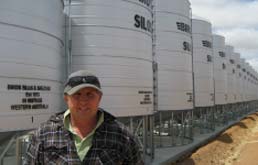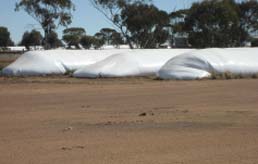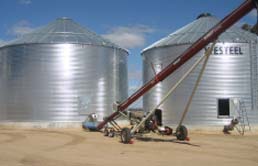Sealed silos
‘Deloraine’, Brad & Kylie Nottle, Kweda, West Corrigin
Grains | Grains pests | Grains product management | Grain storage options | Organic grains product management
There are more options than ever before about where and how growers sell their grain. However, no matter what market is chosen, grain must be free of insects, mould and chemical residues. To get the best return, grain storage needs time and planning, while storage systems must provide a consistent high quality product and have the flexibility to meet market demands.
When considering on-farm grain storage, questions, like “How do I want to market my grain?,” “What storage system do I need?” and “How do I get started?” are commonly asked.
To help get the best out of grain storage systems and avoid potential pitfalls, the grain storage solutions and experiences of three farmers in the WA wheatbelt have been outlined here. Each used different storage solutions to meet their marketing requirements or to enable them to use grain on-farm, but all highlight the importance of spending the time to prepare and maintain on-farm storage.

‘Deloraine’, Brad & Kylie Nottle, Kweda, West Corrigin
The Nottle’s property crops a mix of barley, lupin, peas, wheat and export hay. Following deregulation of the wheat industry, Brad re-assessed how he marketed his grain, and as a result has recently invested in 28 sealed silos, each with a 75 tonne capacity, for on-farm storage.

‘Kerrigan Feedlot’, Trevor & Sharon Hincks, East Hyden
The Hinck’s property consists of a cropping program and cattle feedlot. Trevor has used silo bags in conjunction with fixed grain storage silos, largely for storing feed grain for his feedlot. Trevor feels silo bags fit neatly into his farming system, particularly for short term storage of feed grain, providing the best utilisation of capital.

‘Warra Kairan Farm’, Geoffrey & Vivienne Marshall, East Hyden
The Marshall’s farm concentrates on cropping, including wheat, barley, field peas, canola and saia oats. Geoffrey has invested in six 500 tonne unsealed Westeel aerated silos. The catalyst for Geoffrey to move into on-farm grain storage was managing grain quality.